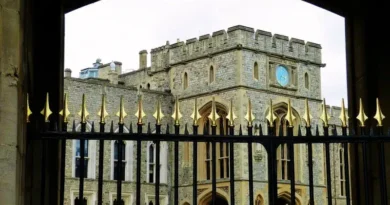Get to Windsor Castle From York
Key Points
- Windsor Castle is approximately 218 miles (351 km) from York via the A1, around 215 miles (346 km) via the M1, and about 232 miles (373 km) via the M1 and M25.
- The best way to travel from York to Windsor Castle is by train, taking approximately 3 hours and 8 minutes via a direct train to London King’s Cross, followed by an underground transfer to Paddington, then a train to Slough, and a final short rail journey to Windsor & Eton Central. This route minimises transfers and offers the quickest journey.
- Alternatively, travelling by car via the A1 is the fastest driving option, taking around 4 hours and 12 minutes.
- Cycling is also possible but requires significant planning, covering over 225 miles and taking nearly 20 hours. For speed and convenience, the train is the most efficient choice.
Traveling from York to Windsor Castle: Route Comparison
| Mode | Route | Duration | Distance | Key Roads/Stations | Transfers | Pros | Cons |
|---|---|---|---|---|---|---|---|
| Car | Via A1 | 4 hr 12 min | 218 miles | A1(M) → A421 → M1 → M25 → M4 → A4 | None | Fastest route, avoids major congestion points | Traffic delays possible |
| Car | Via M1 | 4 hr 20 min | 215 miles | A1(M) → M1 → M25 → M4 → A4 | None | Direct and widely used motorway route | More congestion risk |
| Car | Via M1 & M25 | 4 hr 26 min | 232 miles | A1(M) → M62 → M1 → M25 → M4 → A355 | None | Alternative for avoiding certain traffic hotspots | Longer distance |
| Train | Fastest Route | 3 hr 8 min | N/A | York → King’s Cross → Paddington → Slough → Windsor & Eton Central | 2 | Shortest travel time, express connections | Requires Underground transfer |
| Train | Intermediate Route | 3 hr 20 min | N/A | York → King’s Cross → Vauxhall → Windsor & Eton Riverside | 2 | Fewer Underground transfers | Slightly longer travel time |
| Train | Longest Route | 3 hr 28 min | N/A | York → St Pancras → Farringdon → Slough → Windsor | 3 | More budget-friendly options | More transfers, slower journey |
| Cycle | Via National Cycle Route 64 | 19 hr 55 min | 231 miles | Market Harborough → Lincoln → Windsor | None | Mix of railway paths & roads | Some restricted/private sections |
| Cycle | Via National Cycle Route 62 | 19 hr 48 min | 225 miles | Fleetwood → Selby → Windsor | None | Part of the Trans Pennine Trail | More elevation gain |
| Cycle | Via Route 1 | 20 hr 53 min | 247 miles | East Coast Route via coastal areas | None | Scenic coastal views | Longest route, detours possible |
Getting to Windsor Castle From York By Car
Travelling from York to Windsor Castle by car provides several route options depending on traffic conditions and personal preference. Here are three recommended routes with step-by-step directions.
Route 1: Via A1
- Approximate duration: 4 hr 12 min (under ideal conditions)
- Distance: 218 miles
- Fastest route due to traffic conditions
Directions:
- Depart from York, UK
- Head southeast on Foss Islands Rd/A1036 towards Foss Bank/A1036 (0.6 mi)
- Turn left onto Barbican Rd/A19 and continue to follow A19 (2.0 mi)
- At Fulford Interchange, take the 4th exit onto the A64 ramp towards Leeds/Thirsk/A19/Harrogate/A59 (0.7 mi)
- Follow A1(M), A1, and A1(M) to A421 in Bedford
- Merge onto A64 (11.8 mi)
- Take the A1(M) ramp towards Leeds/M1/Manchester/M62 (1.0 mi)
- Merge onto A1(M) (2.4 mi), continuing onto A1 and A1(M) for a total of 147 miles
- Take A421 and join M1 in Central Bedfordshire
- Take the A421 exit at Black Cat Roundabout and continue for 17.4 miles
- Take the exit towards M1 South and join the motorway
- Follow M1 and M25 to Slough, then take the A4 exit from M4
- Merge onto M1 (24.1 mi)
- Join M25 towards M40/M4/Heathrow Airport (18.8 mi)
- Merge onto M4 (2.2 mi) and take the A4 exit towards Colnbrook/B470/Datchet/Langley (0.3 mi)
- The final approach to Windsor Castle
- Follow B470, taking Major’s Farm Rd, London Rd, and Windsor Rd (3.6 mi)
- Turn left onto Thames St/B3022 and finally onto Castle Hill to reach Windsor Castle
Route 2: Via M1

- Approximate duration: 4 hr 20 min
- Distance: 215 miles
Directions:
- Depart from York, UK following A64 to A1(M) (16.2 mi)
- Take A1(M), M1, and M25 to Slough (195 mi)
- Merge onto A1(M) and continue onto A1
- At junction 35, take M18 towards Sheffield/M1
- Merge onto M18 and take the exit towards M1
- Continue on M1 for approximately 75.9 miles
- At junction 6A, take M25 towards M40/M4/Heathrow Airport
- Merge onto M4 and take the A4 exit towards Colnbrook/B470/Datchet/Langley
- Follow B470 to Castle Hill in Windsor (3.6 mi)
- Follow Major’s Farm Rd, London Rd, Windsor Rd
- Turn onto Thames St/B3022, then onto Castle Hill to arrive at Windsor Castle
Route 3: Via M1 and M25

- Approximate duration: 4 hr 26 min
- Distance: 232 miles
Directions:
- Depart from York, UK following A64 to A1(M) (16.2 mi)
- Take M1 and M25 to Slough, then exit onto A355 (213 mi)
- Take the exit onto M62 towards Manchester
- At junction 29, take the M1 ramp to London/Wakefield
- Continue on M1 for approximately 90.2 miles
- Join M25 at junction 6A
- Merge onto M4 at junction 15 and exit at junction 6 towards A355
- Final approach via Royal Windsor Way and Clarence Road (2.6 mi)
- Follow A332, Clarence Rd, and Victoria St
- Take B3022, turning right onto Castle Hill to reach Windsor Castle
Each route offers different advantages depending on traffic conditions. The A1 route is generally the fastest, while the M1 and M25 options provide alternative approaches to avoid congestion. Always check live traffic updates before departure for the most efficient journey.
Getting to Windsor Castle From York by Train
Travelling from York to Windsor Castle by train involves several route options, each varying in travel time due to factors such as transfers, waiting times, and the number of stops along the way. The journey typically takes between approximately 3 hours and 8 minutes to 3 hours and 28 minutes, depending on the chosen route.
Factors Affecting Travel Time
- Number of Transfers – The fastest routes involve fewer transfers, while those with multiple changes tend to take longer due to waiting times at interchange stations.
- Waiting Times Between Connections – Some routes require longer waiting periods between connections, adding significant time to the overall journey.
- Route Efficiency – Direct connections or faster transfer routes reduce travel time, while routes requiring subway or bus connections can take longer.
- Train Speed and Stops – Some services are express, covering long distances without stopping, whereas others make multiple stops, adding to the journey duration.
Route Comparisons
Fastest Route (3 hours 8 minutes – 3 hours 10 minutes)
- This journey typically involves taking a direct train from York to London King’s Cross, followed by a short walk to the underground.
- After a brief underground trip to Paddington, a train to Slough is taken, followed by a quick transfer to a connecting service to Windsor & Eton Central.
- The advantage of this route is fewer changes and shorter waiting times at interchange points.
Intermediate Route (3 hours 20 minutes)
- This route follows a similar pattern to the fastest route but instead involves taking a train from Vauxhall to Windsor & Eton Riverside rather than transferring at Paddington.
- The key difference is the additional stops made on the way to Windsor, slightly extending the overall journey duration.
- The underground segment via Victoria Line can also add variability to travel times depending on congestion and service frequency.
Longest Route (3 hours 28 minutes)
- The slowest option includes a connection via St Pancras International, taking the Thameslink service to Farringdon before transferring onto the Elizabeth Line to Slough.
- The Elizabeth Line has multiple stops, contributing to the increased duration.
- In some cases, a bus segment introduces potential delays due to traffic and service schedules.
- This route is best suited for those who prefer alternative connections or may find bus access more convenient.
Why Travel Times Vary
- Train Service Differences – Some routes involve express trains with fewer stops, while others rely on local services that make more frequent stops.
- Underground vs. Overground Transfers – Routes that require an underground transfer can be subject to delays, congestion, and longer transfer walks.
- Frequency of Connecting Services – A delay in one train can have a ripple effect, causing increased waiting times at the next transfer point.
- Alternative Transfer Points – Different stations offer varying connection speeds. For instance, Paddington to Slough is a quick transfer, whereas taking the Elizabeth Line via Farringdon introduces more stops and longer journey times.
Choosing the Best Route
- If speed is the priority, opting for the direct train to King’s Cross, followed by the Paddington to Slough transfer, is ideal.
- If preferring a more straightforward route with fewer transfers, choosing the service via Vauxhall can be a good alternative.
- Those flexible with time and seeking a more budget-friendly option may consider the Elizabeth Line route despite its slightly longer duration.
In conclusion, the journey from York to Windsor Castle by train offers multiple routes, each with its own advantages and trade-offs. Understanding the variations in travel time due to stops, waiting periods, and transfer efficiency can help in selecting the most suitable option based on individual preferences and schedules.
Getting to Windsor Castle From York By Cycle
Embarking on a cycling journey from York to Windsor Castle is an ambitious yet rewarding endeavour, covering approximately 225 to 247 miles, depending on the chosen route. This expedition offers an immersive experience through England’s diverse landscapes, historical towns, and scenic countryside. However, it’s crucial to meticulously plan your journey, considering route options, terrain, potential restrictions, and essential preparations to ensure a safe and enjoyable ride.
Route Options
There are primarily three routes to consider for this journey:
- Via National Cycle Route 64: This route spans approximately 231 miles with an estimated cycling time of 19 hours and 55 minutes. It involves an elevation gain of 3,786 feet and a descent of 3,704 feet, with the highest point reaching 623 feet above sea level. However, be aware that certain sections have restricted usage or traverse private roads.
- Via National Cycle Route 62: Covering around 225 miles, this route has an estimated cycling time of 19 hours and 48 minutes. It features a more challenging elevation profile, with an ascent of 5,584 feet and a descent of 5,502 feet, peaking at 653 feet. Similar to Route 64, some segments may have restricted access or involve private roads.
- Via Route 1: This is the longest option, stretching approximately 247 miles with an estimated duration of 20 hours and 53 minutes. It has a relatively moderate elevation gain of 2,425 feet and a descent of 2,343 feet, with the highest point at 397 feet. This route also includes sections with restricted usage or private roads.
Detailed Overview of National Cycle Routes
- National Cycle Route 64: This route runs from Market Harborough to Lincoln, passing through Melton Mowbray and Newark-on-Trent. It utilises former railway paths, offering relatively flat and scenic stretches ideal for cyclists seeking a leisurely ride. However, it’s essential to verify the accessibility of certain segments, as some may traverse private lands or have usage restrictions.
- National Cycle Route 62: Part of the Trans Pennine Trail, Route 62 connects Fleetwood in Lancashire to Selby in North Yorkshire. It offers a mix of traffic-free paths and on-road sections, showcasing diverse terrains from coastal areas to inland countryside. Given its extensive coverage, certain portions may have restricted access or require navigation through private roads.
- Route 1: As part of the National Cycle Network, Route 1 is a long-distance path that runs along the east coast of England. While it provides picturesque coastal views and passes through historic towns, its extended length and potential detours make it a less direct option for reaching Windsor from York. Additionally, cyclists should be mindful of sections with restricted usage or private roadways.
Key Considerations
- Route Planning: Given the potential restrictions and private road segments on these routes, it’s imperative to consult up-to-date maps and resources. The Sustrans website offers detailed information on the National Cycle Network, including current route statuses and any advisories.
- Terrain and Elevation: Each route presents varying elevation profiles. Route 62, for instance, has a more demanding ascent and descent, which may appeal to cyclists seeking a challenging ride. Conversely, Routes 64 and 1 offer more moderate terrains. Assess your fitness level and cycling experience when selecting a route.
- Accommodation and Rest Stops: Plan your journey with overnight stays and rest breaks in mind. Towns such as Melton Mowbray, Newark-on-Trent, and Lincoln along Route 64 or Selby and Doncaster along Route 62 provide opportunities for lodging, dining, and replenishing supplies.
- Safety and Regulations: Always adhere to local traffic laws and cycling regulations. Equip your bicycle with necessary safety gear, including lights, reflectors, and a bell. Wearing a helmet is strongly recommended. Additionally, be prepared for varying weather conditions and carry appropriate clothing and equipment.
Approaching Windsor
As you near your destination, it’s worth noting that Windsor Great Park, a 5,000-acre royal park adjacent to Windsor Castle, offers designated cycling paths. However, cycling is not permitted on horse tracks within the park. For a more adventurous ride, nearby Swinley Forest provides 24 km of mountain biking routes suitable for various skill levels.
Upon reaching Windsor, you’ll find ample cycle parking facilities within the town centre, allowing you to securely leave your bicycle while exploring Windsor Castle and its surroundings.
Final Preparations
- Equipment Check: Ensure your bicycle is in optimal condition, with brakes, gears, and tyres thoroughly inspected. Carry essential tools and spare parts for minor repairs.
- Navigation Aids: Utilise GPS devices or smartphone applications with offline maps to assist with navigation, especially in areas with limited signage or connectivity.
- Physical Preparation: Given the journey’s length and varying terrains, engage in adequate training to build endurance and strength. Incorporate longer rides into your routine leading up to the trip.
- Emergency Planning: Carry a fully charged mobile phone, a portable charger, and a basic first aid kit. Familiarise yourself with emergency contact numbers and the locations of medical facilities along your route.
Embarking on this cycling journey from York to Windsor Castle is not only a test of endurance but also an opportunity to experience England’s rich heritage and natural beauty. With meticulous planning and preparation, it promises to be an unforgettable adventure.
Conclusion
The journey from York to Windsor Castle offers various travel options, each with its own benefits. The train is the most efficient choice for speed and convenience, taking just over three hours with minimal transfers. Driving provides flexibility, with the A1 route generally being the fastest at around four hours and 12 minutes. For cycling enthusiasts, the trip is a challenging yet rewarding endeavour, requiring careful planning and preparation. Ultimately, the best mode of transport depends on individual priorities, whether it be efficiency, comfort, or adventure, ensuring a journey suited to personal preferences.









